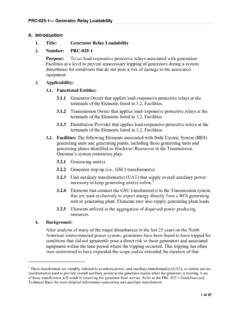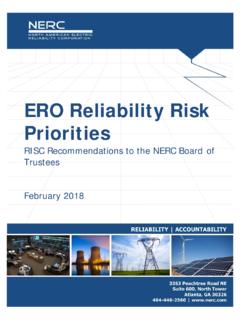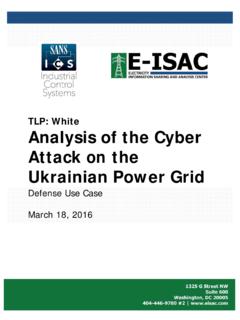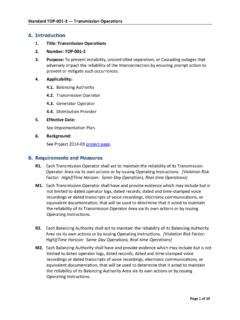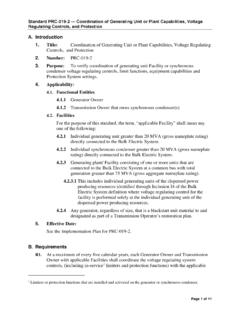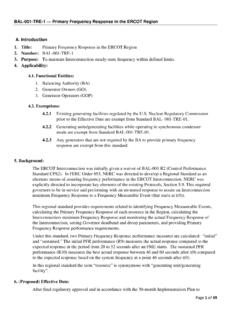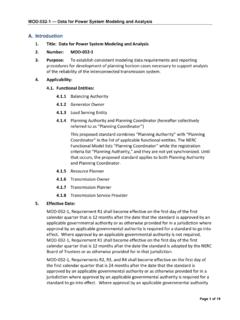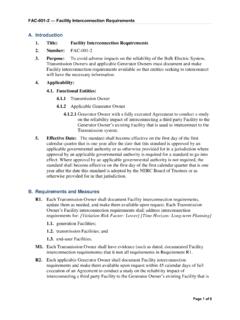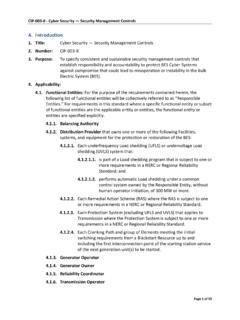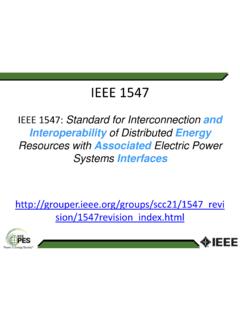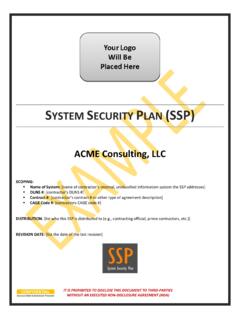Transcription of 1. Title: 2. 3. 4.
1 CIP-007-6 Cyber Security Systems Security Management Page 1 of 51 A. Introduction 1. Title: Cyber Security System Security Management 2. Number: CIP-007-6 3. Purpose: To manage system security by specifying select technical, operational, and procedural requirements in support of protecting BES Cyber Systems against compromise that could lead to misoperation or instability in the Bulk Electric System (BES). 4. Applicability: Functional Entities: For the purpose of the requirements contained herein, the following list of functional entities will be collectively referred to as Responsible Entities. For requirements in this standard where a specific functional entity or subset of functional entities are the applicable entity or entities, the functional entity or entities are specified explicitly. Balancing Authority distribution Provider that owns one or more of the following Facilities, systems, and equipment for the protection or restoration of the BES: Each underfrequency Load shedding (UFLS) or undervoltage Load shedding (UVLS) system that: is part of a Load shedding program that is subject to one or more requirements in a nerc or Regional Reliability Standard; and performs automatic Load shedding under a common control system owned by the Responsible Entity, without human operator initiation, of 300 MW or more.
2 Each Special Protection System (SPS) or Remedial Action Scheme (RAS) where the SPS or RAS is subject to one or more requirements in a nerc or Regional Reliability Standard. Each Protection System (excluding UFLS and UVLS) that applies to Transmission where the Protection System is subject to one or more requirements in a nerc or Regional Reliability Standard. Each Cranking Path and group of Elements meeting the initial switching requirements from a Blackstart Resource up to and including the first interconnection point of the starting station service of the next generation unit(s) to be started. Generator Operator Generator Owner Interchange Coordinator or Interchange Authority Reliability Coordinator CIP-007-6 Cyber Security Systems Security Management Page 2 of 51 Transmission Operator Transmission Owner Facilities: For the purpose of the requirements contained herein, the following Facilities, systems, and equipment owned by each Responsible Entity in above are those to which these requirements are applicable.
3 For requirements in this standard where a specific type of Facilities, system, or equipment or subset of Facilities, systems, and equipment are applicable, these are specified explicitly. distribution Provider: One or more of the following Facilities, systems and equipment owned by the distribution Provider for the protection or restoration of the BES: Each UFLS or UVLS System that: is part of a Load shedding program that is subject to one or more requirements in a nerc or Regional Reliability Standard; and performs automatic Load shedding under a common control system owned by the Responsible Entity, without human operator initiation, of 300 MW or more. Each SPS or RAS where the SPS or RAS is subject to one or more requirements in a nerc or Regional Reliability Standard. Each Protection System (excluding UFLS and UVLS) that applies to Transmission where the Protection System is subject to one or more requirements in a nerc or Regional Reliability Standard.
4 Each Cranking Path and group of Elements meeting the initial switching requirements from a Blackstart Resource up to and including the first interconnection point of the starting station service of the next generation unit(s) to be started. Responsible Entities listed in other than distribution Providers: All BES Facilities. Exemptions: The following are exempt from Standard CIP-007-6: Cyber Assets at Facilities regulated by the Canadian Nuclear Safety Commission. Cyber Assets associated with communication networks and data communication links between discrete Electronic Security Perimeters. The systems, structures, and components that are regulated by the Nuclear Regulatory Commission under a cyber security plan pursuant to 10 Section For distribution Providers, the systems and equipment that are not included in section above. CIP-007-6 Cyber Security Systems Security Management Page 3 of 51 Responsible Entities that identify that they have no BES Cyber Systems categorized as high impact or medium impact according to the identification and categorization processes.
5 5. Effective Dates: See Implementation Plan for CIP-007-6. 6. Background: Standard CIP-007 exists as part of a suite of CIP Standards related to cyber security, which requires the initial identification and categorization of BES Cyber Systems and require a minimum level of organizational, operational and procedural controls to mitigate risk to BES Cyber Systems. Most requirements open with, Each Responsible Entity shall implement one or more documented [processes, plan, etc.] that include the applicable items in [Table Reference]. The referenced table requires the applicable items in the procedures for the requirement s common subject matter. The term documented processes refers to a set of required instructions specific to the Responsible Entity and to achieve a specific outcome. This term does not imply any particular naming or approval structure beyond what is stated in the requirements.
6 An entity should include as much as it believes necessary in its documented processes, but it must address the applicable requirements in the table. The terms program and plan are sometimes used in place of documented processes where it makes sense and is commonly understood. For example, documented processes describing a response are typically referred to as plans ( , incident response plans and recovery plans). Likewise, a security plan can describe an approach involving multiple procedures to address a broad subject matter. Similarly, the term program may refer to the organization s overall implementation of its policies, plans and procedures involving a subject matter. Examples in the standards include the personnel risk assessment program and the personnel training program. The full implementation of the CIP Cyber Security Standards could also be referred to as a program.
7 However, the terms program and plan do not imply any additional requirements beyond what is stated in the standards. Responsible Entities can implement common controls that meet requirements for multiple high and medium impact BES Cyber Systems. For example, a single training program could meet the requirements for training personnel across multiple BES Cyber Systems. Measures for the initial requirement are simply the documented processes themselves. Measures in the table rows provide examples of evidence to show documentation and implementation of applicable items in the documented processes. These measures serve to provide guidance to entities in acceptable records of compliance and should not be viewed as an all-inclusive list. CIP-007-6 Cyber Security Systems Security Management Page 4 of 51 Throughout the standards, unless otherwise stated, bulleted items in the requirements and measures are items that are linked with an or, and numbered items are items that are linked with an and.
8 Many references in the Applicability section use a threshold of 300 MW for UFLS and UVLS. This particular threshold of 300 MW for UVLS and UFLS was provided in Version 1 of the CIP Cyber Security Standards. The threshold remains at 300 MW since it is specifically addressing UVLS and UFLS, which are last ditch efforts to save the BES. A review of UFLS tolerances defined within regional reliability standards for UFLS program requirements to date indicates that the historical value of 300 MW represents an adequate and reasonable threshold value for allowable UFLS operational tolerances. Applicable Systems Columns in Tables: Each table has an Applicable Systems column to further define the scope of systems to which a specific requirement row applies. The CSO706 SDT adapted this concept from the National Institute of Standards and Technology ( NIST ) Risk Management Framework as a way of applying requirements more appropriately based on impact and connectivity characteristics.
9 The following conventions are used in the Applicable Systems column as described. High Impact BES Cyber Systems Applies to BES Cyber Systems categorized as high impact according to the identification and categorization processes. Medium Impact BES Cyber Systems Applies to BES Cyber Systems categorized as medium impact according to the identification and categorization processes. Medium Impact BES Cyber Systems at Control Centers Only applies to medium impact BES Cyber Systems located at a Control Center. Medium Impact BES Cyber Systems with External Routable Connectivity Only applies to medium impact BES Cyber Systems with External Routable Connectivity. This also excludes Cyber Assets in the BES Cyber System that cannot be directly accessed through External Routable Connectivity. Electronic Access Control or Monitoring Systems (EACMS) Applies to each Electronic Access Control or Monitoring System associated with a referenced high impact BES Cyber System or medium impact BES Cyber System in the applicability column.
10 Examples may include, but are not limited to, firewalls, authentication servers, and log monitoring and alerting systems. Physical Access Control Systems (PACS) Applies to each Physical Access Control System associated with a referenced high impact BES Cyber System or medium impact BES Cyber System. CIP-007-6 Cyber Security Systems Security Management Page 5 of 51 Protected Cyber Assets (PCA) Applies to each Protected Cyber Asset associated with a referenced high impact BES Cyber System or medium impact BES Cyber System. CIP-007-6 Cyber Security Systems Security Management Page 6 of 51 B. Requirements and Measures R1. Each Responsible Entity shall implement one or more documented process(es) that collectively include each of the applicable requirement parts in CIP-007-6 Table R1 Ports and Services. [Violation Risk Factor: Medium] [Time Horizon: Same Day Operations.]
